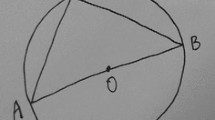Abstract
This paper proposes a novel approach to picture description called constructive picture description. In this approach, the points which specify pictures are defined through repetitive geometrical constructions, and the final image is drawn by referring to those points. This approach fulfills the requirements for picture description: easiness, intuitiveness, uniqueness, and less computation. In addition to that, to clarify the feature of our constructive picture description, we discuss the relationship between our proposal and formal elementary plane geometry. We show the usefulness of constructive picture description through three examples: a generalpurpose preprocessor, apparel patternmaking, and Tibetan mandala image generation.
Similar content being viewed by others
References
Abelson H (1982) A beginner's guide to Logo. BYTE 7(8):88–112
Beynon M, Yung E (1988) Implementing a definitive notation for interactive graphics. In: Magnenat-Thalmann N, Thalmann D (eds) New trends in computer graphics, Proc CG International '88. Springer, Berlin Heidelberg New York London Paris Tokyo, pp 456–468
Bier EA, Stone MC (1986) Snap-dragging. ACM SIGGRAPH Comput Graph 20(4):233–240
Borning A (1981) The programming language aspects of ThingLab, a constraint-oriented simulation laboratory. ACM Trans Program Lang Syst 3(4):353–387
Bunka Fashion College, Bunka Woman's University (eds) (1976), Bunka Apparel Seminar: Lady's Dress I (Bunka Fukusou Kouza: Fujinfuku I). Bunka Publishing Bureau, Tokyo
Fuller N, Prusinkiewicz P (1988) Geometric modeling with Euclidean constructions. In: Magnenat-Thalmann N, Thalmann D (eds) New trends in computer graphics, Proc CG International '88. Springer, Berlin Heidelberg New York London Paris Tokyo, pp 379–391
Gosling J (1983) Algebraic constraints. CMU Tech Rep CMU-CS-83-132, Department of Computer Science, Carnegie-Mellon University, Pittsburgh, Pennsylvania
Ito H (ed) (1988) Mode et mode 253. Mode et mode, Tokyo
Kernighan BW, Cherry LL (1975) A system for typesetting mathematics. Commun ACM 18(3):151–157
Kin N, Noma T, Kunii TL, Enomoto H (1988) A drawing input method and its implementation using a preprocessor. In: Proc 36th Annual Conf. Information Processing Society of Japan, Tokyo, pp 2109–2110
Knuth DE (1986) The METAFONTbook. Addison-Wesley, Reading, Massachusetts
Kopp E, Rolfo V, Zelin B, Gross L (1981) Designing apparel through the flat pattern (revised 5th edn). Fairchild Publications, New York
Moise EE (1974) Elementary geometry from an advanced standpoint (2nd edn). Addison-Wesley, Reading, Massachusetts
Nelson G (1985) Juno, a constraint-based graphics system. ACM SIGGRAPH Comput Graph 19(3):235–243
Noma T, Terai K, Kunii TL (1986) VIRGO: a computer-aided apparel pattern-making system. In: Kunii TL (ed) Advanced computer graphics, Proc Computer Graphics Tokyo '86. Springer, Tokyo Berlin Heidelberg New York, pp 379–401
Noma T, Kunii TL, Kin N, Enomoto H, Aso E, Yamamoto T (1988) Drawing input through geometrical constructions: specification and applications. In: Magnenat-Thalmann N, Thalmann D (eds) New trends in computer graphics, Proc CG International '88. Springer, Berlin Heidelberg New York, pp 403–415
Stroustrup B (1988) What is object-oriented programming? IEEE Softw 5(3):10–20
Sugaya K, Sugaya F (1967) Sugaya cutting (Sugaya-shiki saidan: kisohen) Sugaya Fukusou Gakuin Publishing, Tokyo
Sugino Y (1980) Introduction to Doreme dressmaking (Doreme-shiki yousai nyuumon). Kamakura Shobou Publishing, Tokyo
Sutherland IE (1963) Sketchpad: a man-machine graphical communication system. In: Proc Spring Joint Comput Conf pp 329–346
Tanaka C (1988) Dress (Fukusou) 1988 (Summer). Tanaka Chiyo Gakuen, Tokyo
White RM (1988) Applying direct manipulation to geometric construction systems. In: Magnenat-Thalmann N, Thalmann D (eds) New trends in computer graphics, Proc CG International '88. Springer, Berlin Heidelberg New York, pp 446–455
Van Wyk CJ (1982) A high-level language for specifying pictures. ACM Trans Graph 1(2):163–182
Yoshimura K (1978) Percent-type dressmaking (Wariaijakushiki yasashii yousai). Japan Broadcast Publishing, Tokyo
Author information
Authors and Affiliations
Rights and permissions
About this article
Cite this article
Noma, T., Kunii, T.L., Kin, N. et al. Constructive picture description with Euclidean geometry. The Visual Computer 5, 40–52 (1989). https://doi.org/10.1007/BF01901480
Issue Date:
DOI: https://doi.org/10.1007/BF01901480




